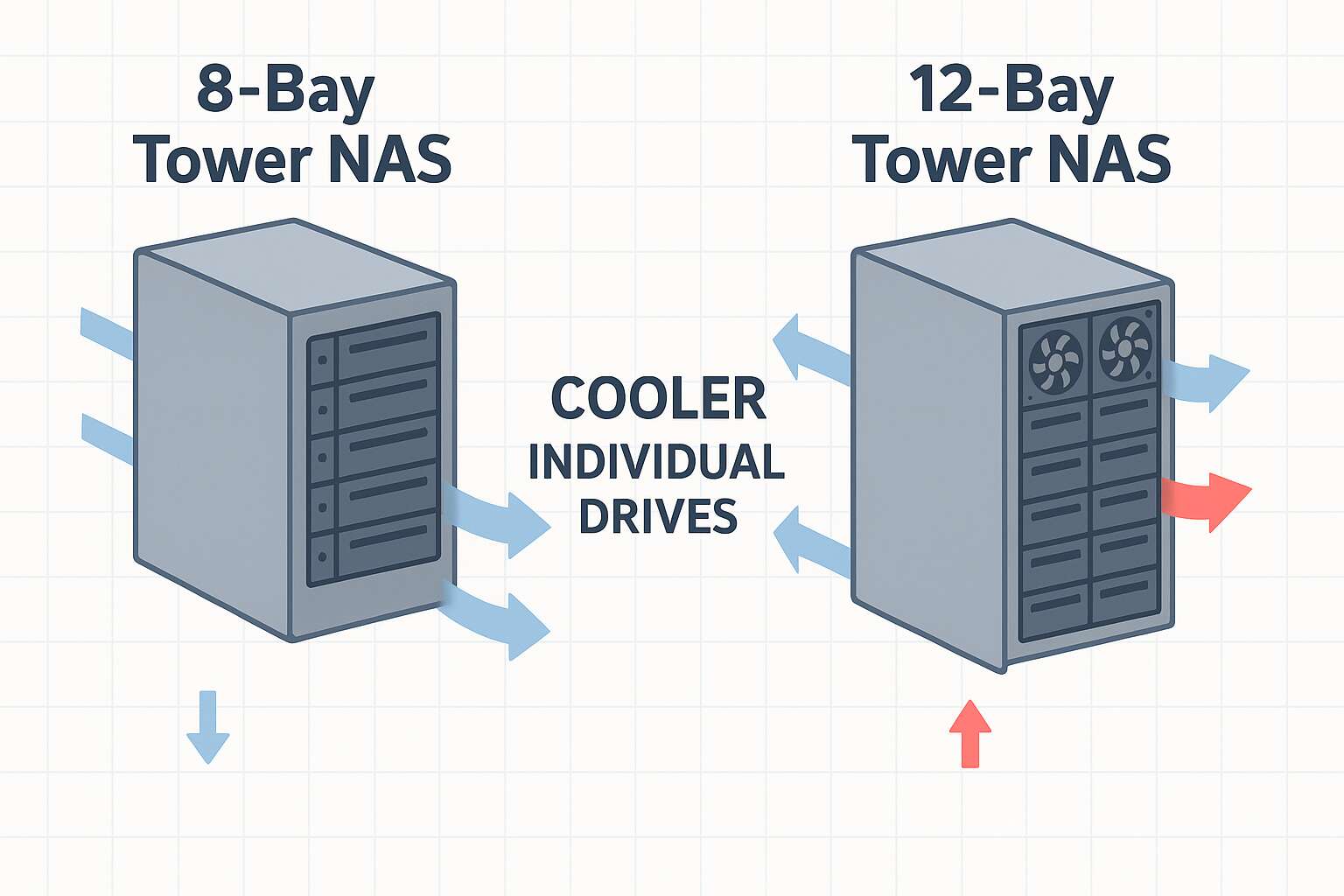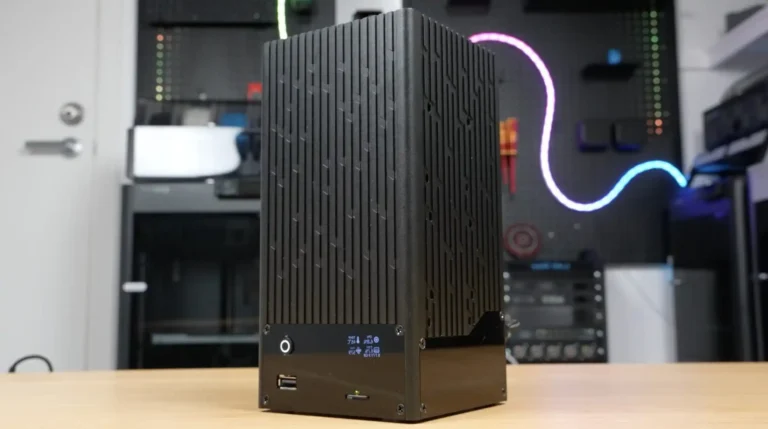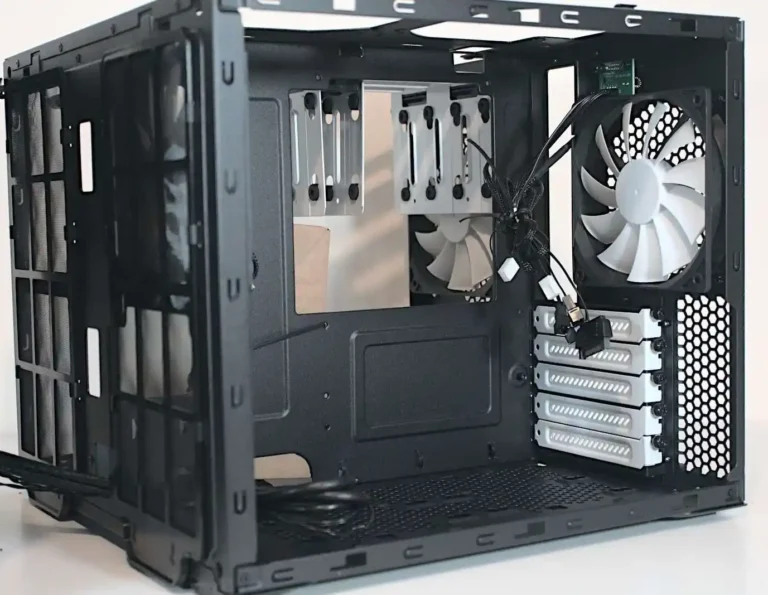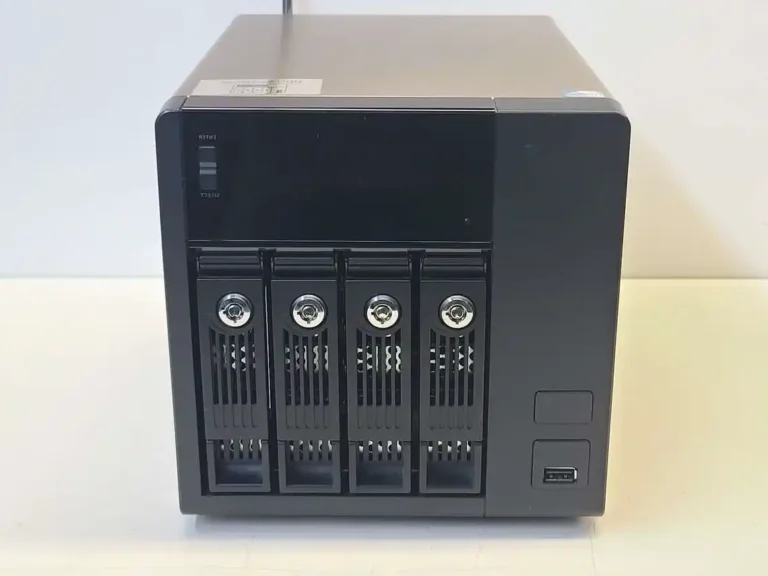أنت تختار بين 8 فتحات و12 فتحة NAS. على الورق “أربع فتحات إضافية”. أما في الحامل أو على مكتبك، فإن الأمر يتعلق بتدفق الهواء والضوضاء ودرجة حرارة محرك الأقراص ومدى سرعة صيانة القرص الفاشل. دعنا نسير في الأمر بأسلوب العالم الحقيقي - قصير وقوي ومفيد.
أساسيات تبريد NAS: تدفق الهواء، والضغط الساكن، وحجم المروحة
تعمل المحركات على تسليط الحرارة دون توقف. يعمل التبريد عندما يذهب الهواء من الأمام إلى الخلف من خلال كومة محرك الأقراص، وليس حولها. عادةً ما تعتمد الصناديق البرجية على مراوح مزدوجة مقاس 120 مم: شفرات كبيرة، دوران أبطأ، نغمة أكثر هدوءًا. غالبًا ما تستخدم معدات Rackmount 2U مراوح أصغر وأسرع لدفع الضغط الساكن من خلال أقفاص كثيفة. تعمل الخلجان الأكثر كثافة على تشديد المسار؛ أي تسرب أو غبار يبطئ التدفق وتزحف درجات الحرارة. حقيقة بسيطة: تتطلب الخلجان الأكثر كثافة إحكامًا أكثر إحكامًا وضغطًا أفضل.
شبكة NAS ذات 8 فتحات مقابل 12 فتحة تبريد وكثافة شبكة NAS ذات 12 فتحة
أن 8 فتحات غالباً ما يبقى البرج هادئاً في الدورات المنخفضة في الدقيقة. A 12 خزانة البرج مع نفس الشيء يجب أن يعمل تخطيط المروحة بجهد أكبر للحفاظ على تدفق الهواء لكل محرك أقراص مماثل، لذلك يميل إلى زيادة السرعة أثناء عمليات فحص التكافؤ أو إعادة البناء أو عمليات التنظيف الكبيرة. A 12 خزان 12 في 2U يقلب السيناريو: ضغط قوي، وتدفق هواء رائع من الأمام إلى الخلف، لكن المظهر الصوتي يقفز. اختر ما يؤلمك: ميزانية الضوضاء أو ميزانية المساحة.
التركيب على الحامل مقابل البرج: اعتبارات علبة الكمبيوتر المحمول على حامل الخادم
الذهاب إلى الحامل؟ تهتم بـ الترشيح الأمامي, ألواح الطمسو القضبان. مناسب علبة كمبيوتر كمبيوتر رف الخادم يتيح لك إغلاق السحب، وتوجيه الهواء عبر الأقفاص، وتحريك الهيكل للتبديل السريع - بدون مصارعة. في خزانة غرفة المعيشة أو الاستوديو، عادةً ما يفوز برج NAS المزود بمراوح كبيرة من حيث النغمة والراحة. موائل مختلفة، فائزون مختلفون.
الجدول: مقارنة سريعة لمقايضات التبريد
| عامل الشكل | الخلجان | مراوح النظام النموذجية | مسار تدفق الهواء | ملف تعريف الضوضاء | إمكانية الخدمة | الأفضل لـ |
|---|---|---|---|---|---|---|
| البرج | 8 | مزدوج 120 مم | جيد مع الحد الأدنى من الختم | هادئ في وضع الخمول/الحمولة | مسامير جانبية مفتوحة، براغي أساسية | المختبر المنزلي، المكتب الهادئ، حصة الفرع |
| البرج | 12 | مزدوج 120 مم | يحتاج إلى ختم وحشوات أفضل | أعلى أثناء عمليات إعادة البناء | مشابه لـ 8 فتحات | الفرق الإعلامية، الشركات الصغيرة والمتوسطة التي تحتاج إلى خانات إضافية |
| حامل 2U 2U | 12 | متعددة صغيرة متعددة عالية السرعة في الدقيقة | ضغط قوي من خلال الأقفاص | صوت أعلى بشكل ملحوظ | القضبان، ملاءمة التبديل السريع | خزائن البيانات، ورفوف MDR/MSP، ورفوف التجهيز |
ملاحظة: يعتمد “الهدوء/الصوت العالي” على منحنيات المروحة والمرشحات وحجم الغرفة والحرارة المحيطة. ستختلف الأميال التي تقطعها قليلاً.
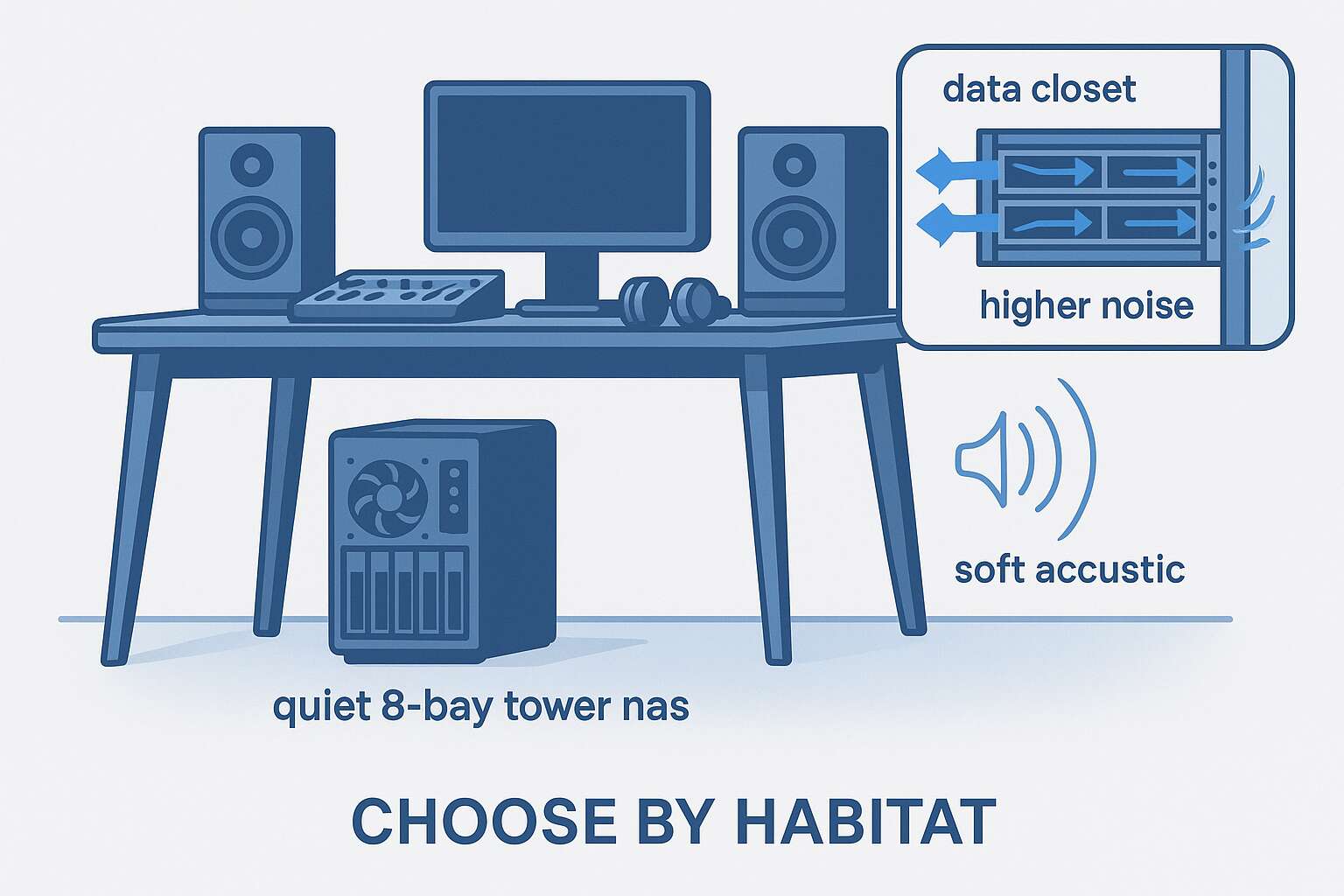
السيناريوهات: الاختيار حسب الوظيفة، وليس حسب الحلم
مختبر منزلي/استوديو المبدعين (تبريد برج NAS)
أنت لا تريد نفقاً هوائياً. يحافظ البرج المكون من 8 فتحات مع عوادم 120 مم على أزيز منخفض ودرجة حرارة مستقرة إذا حافظت على نظافة المرشحات. إذا كنت قد تنمو إلى 12 في وقت لاحق، ابدأ بهيكل يحتوي على حشوات فتحات مناسبة جاهزة. ألق نظرة على أجهزة NAS و حالة ITX إذا كنت تحب التركيبات المدمجة ذات مسارات تدفق الهواء المستقيمة.
المكتب الفرعي/حصة الشركات الصغيرة والمتوسطة (حالة الكمبيوتر الشخصي للخادم)
بالنسبة لخادم ملفات فريق صغير، فإن الخادم المكون من 8 فتحات يلبي معظم المشاركات والنسخ الاحتياطية وأقراص الأجهزة الافتراضية بشكل جيد. ستعجبك الصوتيات الأكثر هدوءاً وانحدار أقل للمروحة في ظل الحمل المختلط. إذا كنت تعلم أن النمو قادم، فلا يزال البرج المكون من 12 فتحة مناسبًا - فقط خطط ل الطمس, وانضباط الكابلات والتحكم في الغبار عندما تحتاج إلى علبة كمبيوتر الخادم مع وجود مساحة للتخزين بالإضافة إلى NICs/HBAs، اتبع هذا المسار.
خزانة البيانات / رف خزانة البيانات / رف موفر خدمة MSP (خادم حالة الكمبيوتر)
يفوز الحامل عندما تهتم بالكثافة و MTTR. قضبان منزلقة، وصواني ذات ملصقات، ومرشحات يمكن الوصول إليها من الأمام - تم. A خادم حالة الكمبيوتر في 2U أو 3U مع ترشيح سحب لائق يحافظ على الضغط والصيانة بسرعة. إنه أعلى صوتاً، نعم، لكن الخزانة لا تمانع.
مجموعات بيانات الذكاء الاصطناعي/استيعاب الوسائط (مجاورة لوحدة معالجة الرسومات)
إذا قمت بوضع مجموعات البيانات الكبيرة بالقرب من الحوسبة ووحدات التخزين ووحدات معالجة الرسومات جنبًا إلى جنب. استخدم حامل رفًا فسيحًا واسعًا مزودًا بمأخذ قوي وقنوات مستقيمة حتى لا تخبز الأقراص خلف المسرعات الساخنة. قم بإقران هيكل التخزين مع حالة خادم وحدة معالجة الرسومات لممرات تدفق هواء نظيفة بين محركات الأقراص والبطاقات. حافظ على المآخذ محكمة الغلق؛ لا تدع العادم الساخن يتدفق إلى الأمام.
الحجج الرئيسية والملاحظات المدعمة بالبيانات (بلغة إنجليزية بسيطة)
مراوح NAS البرجية مقاس 120 مم: تدفق هواء 8 فتحات مقابل 12 فتحة لكل محرك أقراص
نفس مواصفات المروحة، المزيد من الخلجان. هذا يعني تدفق هواء أضيق لكل محرك أقراص في 12 فتحة ما لم ترفع عدد الدورات في الدقيقة أو ترتب مسار الضغط. استخدم حشوات الفتحات وأغلق فجوات الإطار وأبعد الكابلات عن مسار السحب.
حامل رف 2U 2U ذو 12 حجرة: الضغط الساكن والضوضاء
مراوح صغيرة بسرعة دوران أعلى في الدقيقة تخترق الأقفاص الكثيفة. تحصل على تبريد رائع تحت ضغط إعادة البناء، لكن النغمة أكثر حدة. في غرفة الحامل، لا بأس بذلك؛ أما في غرفة المعيشة، فليس كذلك.
درجة الحرارة مقابل الموثوقية: البقاء في نطاق الراحة
تتحمل الأقراص نطاقًا. يزداد الخطر عندما تعمل بالقرب من أعلى هذا النطاق لفترات طويلة أو تنشئ نقاطًا ساخنة. ركز على مستقرة درجات الحرارة، وليس مطاردة أدنى رقم مطلق. تتفوق المنحنيات الملساء على المنحنيات الشائكة.
ألواح العزل، والمرشحات، وانخفاض الضغط
تصبح الخلجان الفارغة تسريبات. بدون حشوات، يختصر الهواء حول محركات الأقراص وليس من خلالها. تضيف فلاتر الغبار والشبكة الضيقة مقاومة؛ نظفها بانتظام أو ارفع ضغط المروحة قليلاً. لا تفرط في شبكة السحب إلا إذا كنت تحب منحدر المروحة.
المراوح الأكبر حجماً مقابل المراوح الأصغر حجماً: مقايضة الطاقة/الضوضاء
تحرك المراوح الكبيرة الهواء نفسه بسرعة دوران أقل في الدقيقة. تحتاج المراوح الأصغر حجماً إلى سرعة أكبر، مما يضيف هسهسة. إذا كنت تريد الهدوء، فاختر هيكلاً يقبل مراوح دوارة أكبر، أو وحدة رف أطول مع تدفق هواء أكثر هدوءاً.
الضوضاء في المساحات المنزلية: حافظ على النغمة الودية
يتغلب الأزيز منخفض التردد على الأزيز عالي التردد. عادة ما تحافظ الأبراج المزودة بعوادم 120 مم على الأزيز. ضع الصندوق على أرض صلبة، وتجنب الخزانات المجوفة، ودع الجزء الخلفي يتنفس. القليل من اختراق الموضع يذهب بعيدًا.
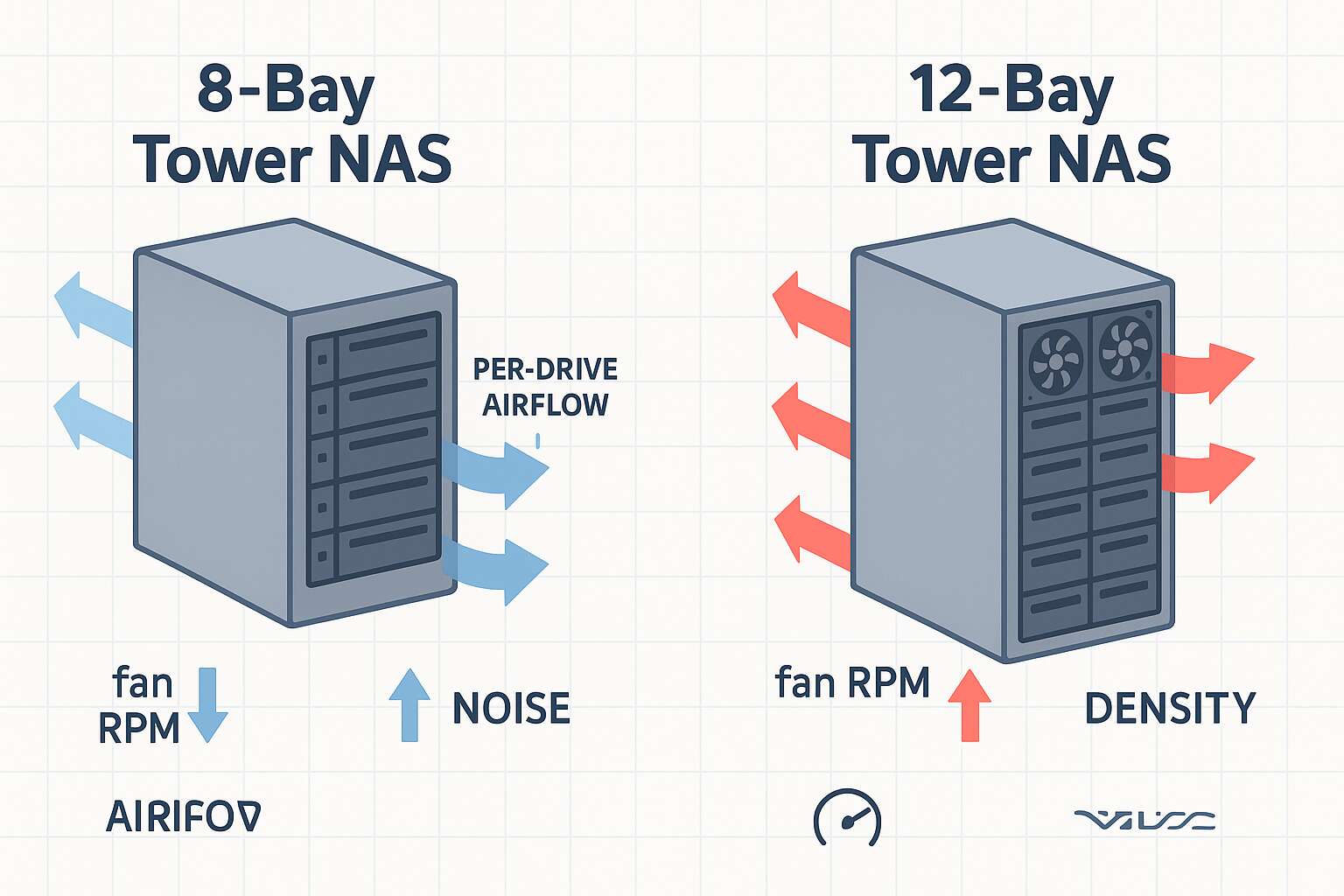
قائمة مراجعة الضبط العملي (نسخ ولصق في مستند الإنشاء الخاص بك)
- سدّ المسار: قم بتركيب صواني الطمس في الخلجان غير المستخدمة.
- حافظ على نظافة الغبار: نظف المرشحات الأمامية؛ لا تكدسها.
- من الأمام إلى الخلف فقط: لا توجد تسريبات جانبية، ولا تعديلات على المروحة خارج المحور.
- خريطة الكابلات: قم بتوجيه SAS/SATA بدقة؛ لا تلفها عبر السحب.
- منحنيات المروحة: قم بتعيين عدد دورات في الدقيقة الأساسية هادئة، وقم بالزيادة بسلاسة في ظل إعادة البناء.
- تخطيط المحرك: نشر المغازل الساخنة؛ تحقق من وجود نقاط ساخنة محلية.
- القضبان: خطة للسحب. سكة توجيه الشاسيه تقصير وقت التوقف عن العمل، وحفظ الأصابع.
تصميمات ATX: نصائح لحالة الخادم ATX
إذا كنت تقوم ببناء صندوق تخزين هجين حول ATX، فاختر حالة خادم atx مع مدخل مستقيم وقناة شفافة من الفتحات الأمامية إلى المراوح الخلفية. تجنب الفتحات الزخرفية التي تنزف الضغط. إذا كان لا بد من إضافة جدار مروحة أمامية، فقم بمطابقته مع فلتر غبار مرتب وإطار صلب.
لماذا تظهر IStoneCase في هذه الاختيارات (OEM/ODM، صديقة للبيئة بالجملة)
يركز IStoneCase على علبة وحدة معالجة الرسومات/هيكل الخادم وهيكل التخزين مع خيارات OEM/ODM. هذا يعني أنه يمكنك طلب جدران مروحة مخصصة، أو فلاتر مثبتة مسبقًا، أو مجموعات قضبان محددة، أو أعداد الفتحات المضبوطة حسب مجموعتك. عمليات الشراء بالجملة لمراكز البيانات، ومختبرات الأبحاث، ومزودي خدمات MSP، والبناة أمر طبيعي. أنت تجلب عبء العمل، ونحن نشارك في تصميم الهيكل ليناسب: أهداف تدفق الهواء، والأهداف الصوتية، وأسلوب الخدمة. ابدأ بالمحور وانتقل حسب الحاجة: الصفحة الرئيسية لـ IStoneCase, ثم علبة تركيب على حامل, حالة الخادم, أجهزة NAS, علبة الحائط.

